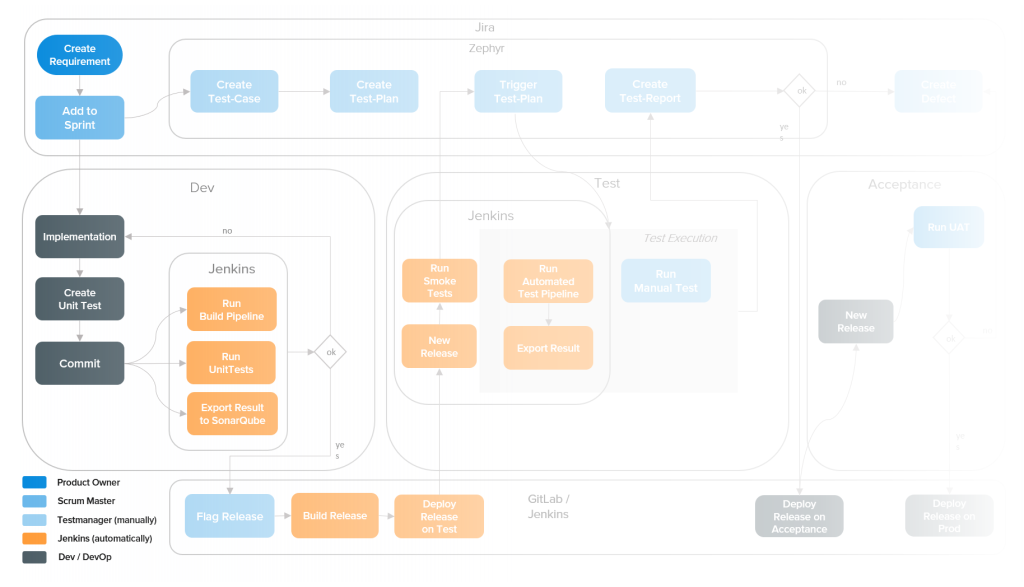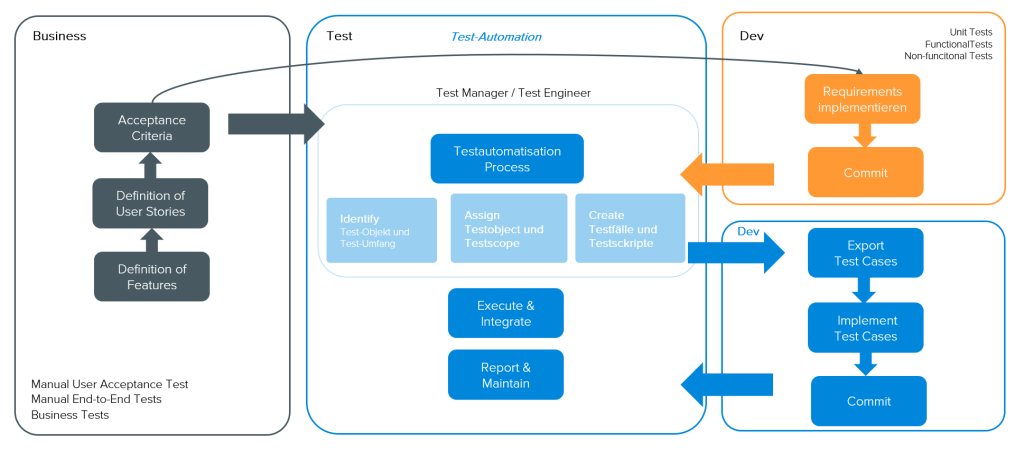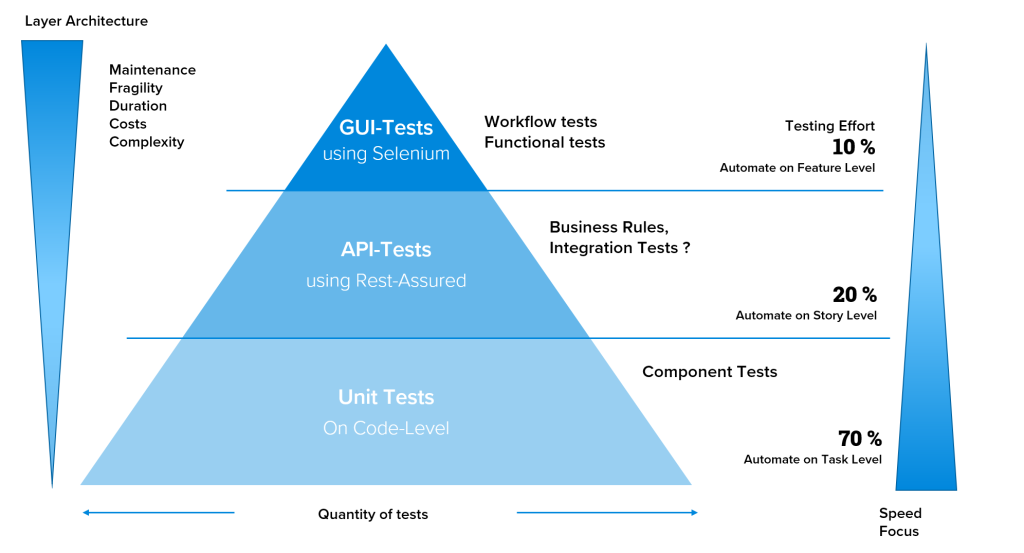Mastering test automation in software development

In today’s software development, short development cycles are a prerequisite for meeting the demands of the market. Test automation is therefore essential to ensure the quality of the software in the long term. With automated tests, companies can develop faster and at the same time ensure higher software quality. As a result, savings of up to 30 and 90% respectively can be achieved in both test costs and test time. In addition, a return on investment (ROI) of up to 100% is possible within two years of test automation.
Advantages of test automation
The introduction of test automation has many advantages:
- Savings of up to 30-50% of test costs
- Return on investment (ROI): ROI of up to 100% within the first two years after the introduction of test automation.
- Reduction of test time by up to 90%, especially for recurring regression tests
- Quality assurance
- More frequent releases: shortening release cycles from months to weeks or even days
- Accelerated further development: through faster feedback to developers and the associated bug fixing.
- High level of standardisation through defined, proven processes and responsibilities
- Flexibility through short iterations and retros
- Clear communication and status reports
- Transparency of processes and those responsible
- Performance measurement thanks to reports
Challenges of test automation
The challenges of test automation are manifold and require careful planning and execution. One fundamental challenge is to build up the expertise of employees so that they can effectively develop and maintain automated test cases. No less important is defining the right test cases. Here, it is often more realistic to aim for 70% coverage of functionalities rather than pushing for full coverage, which is often neither practical nor cost-effective. In addition, the adaptation and maintenance of test cases requires continuous attention in order to keep pace with changes in the software applications.
The integration of the test team into the development process and the early planning of new features into the test concept are also crucial. This includes considering the impact of new features on existing test cases, which increases complexity and requires a well-thought-out test strategy and precise test planning.
Other critical aspects are the quality and maintainability of the test data and the test artefacts themselves. Guaranteeing valid test data for every scenario and ensuring a consistent structure and utilisation of the test libraries are essential for effective test runs. High maintenance efforts,
especially the editing and customisation of test scripts, are often challenging. Artificial intelligence (AI) can offer a solution here by supporting automated processes for the maintenance and optimisation of test cases, which can improve the efficiency and effectiveness of test automation overall.
Integration test automation
In order to meet these challenges, precise planning of the automation of tests for the development of a product is necessary. It is helpful to bundle the activities and roles in a test hub with the following steps:
1. Discovery Phase
The goals of the discovery phase are:
- Understanding the context, challenges and needs: Only with a full understanding of the specific context of the project can customised solutions be developed that cover the actual needs.
- Recognising and minimising risks: By proactively analysing risks negative impacts on the project can be avoided and a stable basis for development can be created.
- Holistic illumination of the project environment: A comprehensive illumination of the project environment with regard to both technical and organisational processes ensures a comprehensive understanding of the project landscape.
- Make the start of development as simple as possible: Clear processes, easy-to-understand instructions and a well-prepared infrastructure make it easier for everyone involved to get started.
2. Managing and planning
Issues such as the right test automation tools, definition of roles and responsibilities and the use of an appropriate test architecture must be clarified in advance.
Only then can the actual planning and control begin. The following aspects need to be considered during planning:
Development of automation strategies
Ensuring seamless integration of the tests in the build pipeline
Creation of a test concept
Specification of tests, taking into account the layer architecture (test pyramid)
The diagram shows that the costs, complexity, maintenance effort, duration/performance and fragility for GUI tests are far higher than for unit or API tests. Therefore, a sensible distribution taking into account the criteria mentioned above is absolutely essential:
- Layered architecture makes it possible to define test-specific layers that cover different aspects of the system
- Lowest level: Unit tests that test individual code sections and functions. By finding errors early on in this phase, problems can be rectified cost-effectively before they affect higher layers.
- Middle level: API tests that test the interfaces between the various components. Here it is checked whether the data is sent to the server and processed correctly, which ensures the integrity of the communication paths.
Requirements for test automation tools
- Ease of use of the tools, as this makes it easier to get started and shortens the learning curve for the test team.
- Comprehensive log output for detailed logging to analyse the test results in order to draw conclusions about the quality of the tested system.
- Recording of user tests to simplify the creation of test scenarios by recording user actions.
- Recording of test scripts and test activities for the systematic and repeatable execution of software tests.
- Recording of test execution through screenshots or videos for visual documentation of process steps.
- Simple programming language or low-code options to make it easier for less experienced team members to create and maintain the tests, thereby increasing the productivity of the team.
- Parameterisation to keep maintenance efforts low and achieve greater flexibility in the execution of test scripts
Roles and responsibilities
- The test manager is responsible for the test concept. He ensures that the software meets the quality standards and fulfils all requirements.
- The test engineer is responsible for defining the test cases and executing the test cycles as well as analysing the test reports
3. Project phase: realisation and implementation
In the project phase, the infrastructure and the tool chain are set up on the basis of the analyses and definitions carried out in the previous phases.
Piloting and stabilisation as part of a proof of concept (PoC) is also useful.
The implementation of a critical workflow (standard use case) is crucial in order to gain initial experience, avoid errors and be able to react quickly. It is equally important to adapt and create an operating manual and technical documentation.
Comprehensive training of all project members is essential to enable the test team to implement automated tests quickly. Training and know-how transfer sessions are crucial elements in enabling the test team to act quickly.
Test automation with artificial intelligence
In order to fully utilise the benefits of test automation, the use of AI is essential. AI offers numerous support approaches for carrying out test automation in a cost- and resource-efficient manner. It can support the following tasks, among others:
- Creation of test cases (guided test case design)
- Determination of test coverage
- Creation & implementation of the Gherkin tests
- Visualisation of test cases (test-based modelling)
- Determination of standard case deviation (GUI test)
- Analysing errors (classification)
Conclusion
Test automation is particularly important for long-term and medium-sized to large software development projects. With well thought-out structuring and planning, it offers numerous advantages: it speeds up the development process, reduces costs and significantly improves the quality of the software. However, successful test automation requires careful planning, a comprehensive test concept and the use of modern test tools and technologies.

Blue Print für your Test Automation
Easily integrate and implement test automation. How can you do this? Find out more in our e-paper!

